 She's a rare example of prey that's more dangerous than her predators. 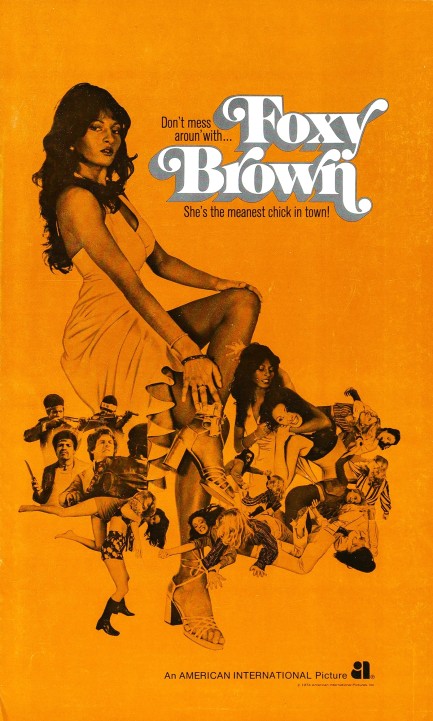 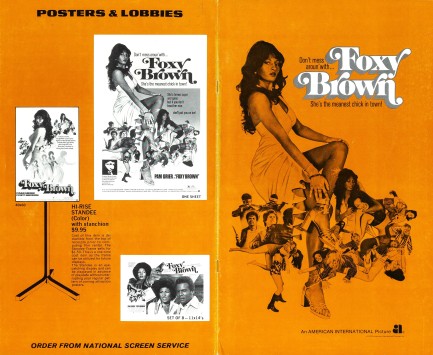
Above is a fun pressbook cover for the legendary Pam Grier's classic action movie Foxy Brown, a tangled tale of drug dealers, crooked cops, loan sharks, and narcs, which premiered in the U.S. today in 1974. When pressed against the wall Grier gets just as vicious as her screen foes. She even sets one guy on fire and runs another over—with a plane. There are no holds barred in blaxploitation cinema.
Below we also have various lobby cards from the film. These are interesting because they're made from production photos that you don't typically see online. It's too bad Grier's blaxploitation/action phase was short, because she was good in the films, even when the films weren't good enough for her. But every artist seeks to hone their craft, so we imagine she got tired of such roles. That's okay—her output, though limited, is always fun to re-watch.
As a side note, the hazards of blogging during the unethical digital age are amply illustrated here. Users on both Alamy and Getty attempt to assert copyright on these items, but movie promos are made for non-copyright holders to publicize the works depicted, and despite claims to the contrary individuals can't hold copyright on them. There are probably hundreds or thousands of these reproductions out there, all individually possessed, so a specific person claiming copyright is nonsensical on the face of it. Only the issuing studio holds copyright.
Even so, we occasionally get threatening e-mails from digital photo resellers. They're AI generated and automatically sent, which means they'll only increase in number as time goes by. We have a form e-mail we send back demanding proof of copyright. We never get a reply to it. Shockingly. We'll say this though—one day corporate greed will kill the blogging culture the same way it's killed most everything else. But that day isn't today. Read what we thought about Foxy Brown here.
 Grier is ready for a battle royal. 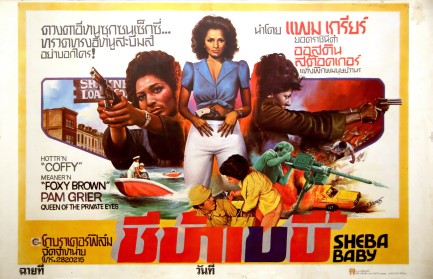
Above you see a rare Thai poster for Pam Grier's 1975 detective thriller Sheba, Baby. The text refers to Grier as the “queen of hearts,” and the “queen of private eyes,” which we think is rather nice. But why stop there? Since the distributors at Go Brother Film were so eager to crown her, let's cover all bases and go with the Queen of Thailand—with respect to Suthida Bajrasudhabimalalakshana. The poster has a date of some sort, but we can't interpret it. Since the movie didn't make it to Europe until late 1976 at the earliest, we're inclined to think the date refers to a Thai premiere in ’77 or ’78. There's also a signature that we can't read. It's a shame not to be able to give the artist credit, but that's the way it goes sometimes. Read more about Sheba, Baby here, and see a cool Egyptian promo poster for it here. 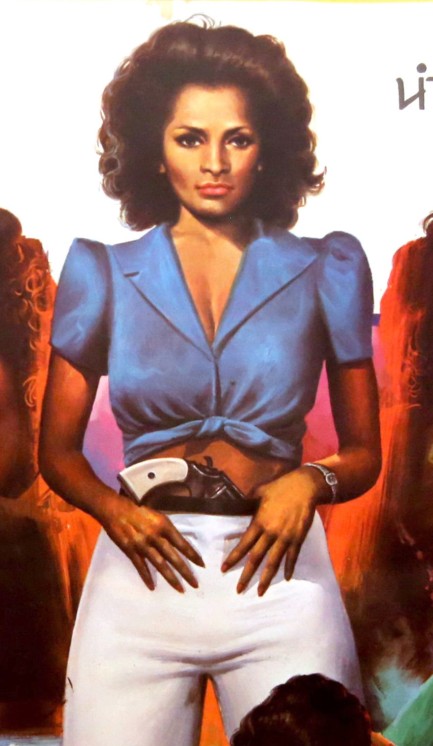
 Let's have phone sex. First I'll send you a photo to inspire you. It should be in your mailbox in three or four days. 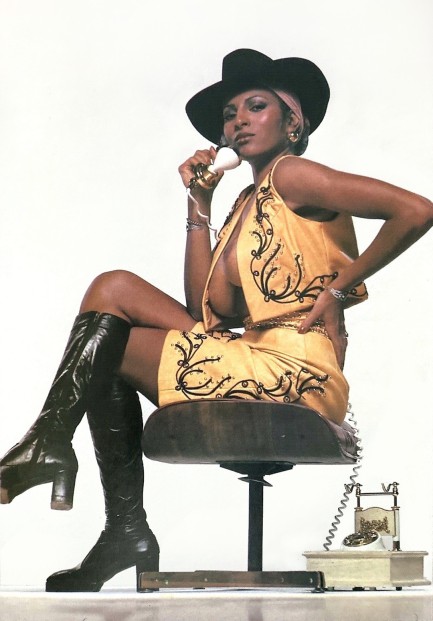
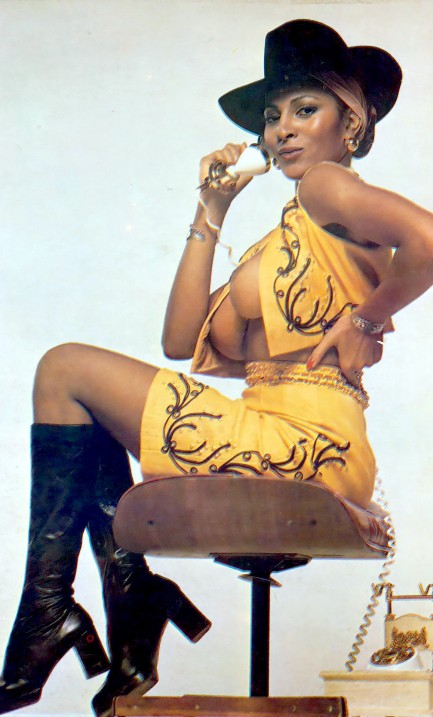 Above you see a rare image from Players magazine circa 1974 of cinema legend Pam Grier using a device known as a rotary telephone. It's a great shot of both her and the museum piece. A couple of other frames from her hang-out session exist that were used in the offshoot publication Players Girls Pictorial in 1976. Above you see a rare image from Players magazine circa 1974 of cinema legend Pam Grier using a device known as a rotary telephone. It's a great shot of both her and the museum piece. A couple of other frames from her hang-out session exist that were used in the offshoot publication Players Girls Pictorial in 1976.
Grier saw nudity as liberating and empowering. In a Rolling Stone interview she said, about the choice to appear unclothed in films, “I wanted to make people start seeing women of color, because we weren’t the epitome of sexual attraction for the male audience, in movies, magazines, anything. I said, How come we don’t see women of color in Hollywood and see them beautifully, like Fellini and Bertolucci and Bergman see women?”
With her boldness Grier helped change the paradigm of onscreen sexuality a bit, and today her images are among the most coveted out there, with magazines in which she appeared nude often auctioning for more than a hundred dollars. Tall, angular, and lovely, she went from actress to cultural icon and maintains that status today. You can see all kinds of Grier in the website. Just click her keywords below.
 The dress doesn't work as camouflage, but as a fashion statement it's tops. 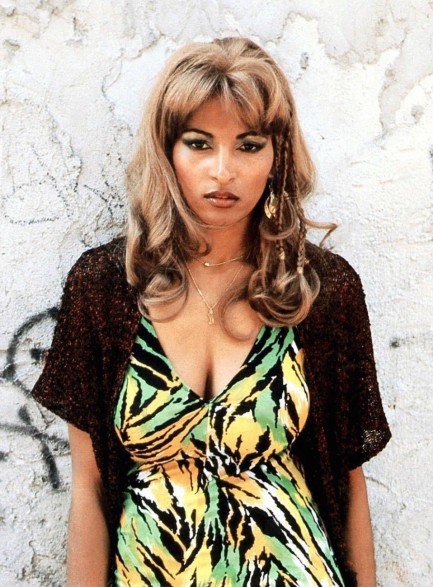
Pam Grier posed for this photo when she was making the a-list crime drama Fort Apache, The Bronx, which was headlined by superstar Paul Newman. Grier was far down the cast list, playing a drug addict prostitute. It was quite a demotion from her starring roles during the blaxploitation era, but the movie was a big hit. She'd finally be toplisted in a mainstream Hollywood movie when Quentin Tarantino cast her in 1997's Jackie Brown, and it was worth the wait. This shot is from 1981.
 Unlike mama's boys, they're fully able to take care of themselves. 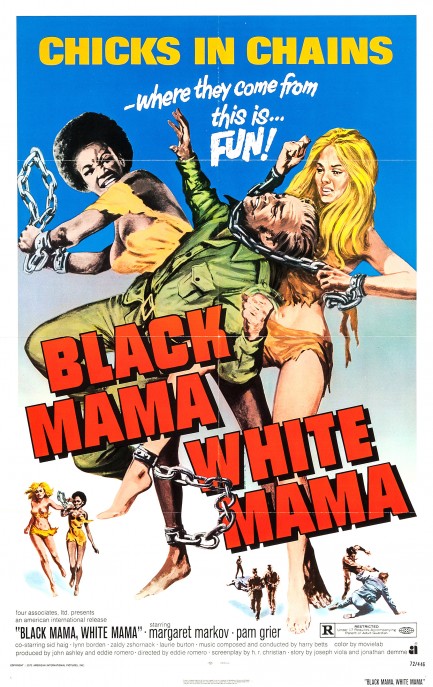
Ages ago we shared a Turkish poster for the blaxploitation flick Black Mama, White Mama, with Pam Grier and Margaret Markov. Today we're sharing the U.S. promo, as well as a nice production photo of the stars. The movie, which premiered today in 1972, was a regendering of The Defiant Ones, but done with a lot more skin and a lot less budget. Even so, it was pretty fun, as women-in-prison flicks go—if you start with modest expectations. You can see more promos from the film here.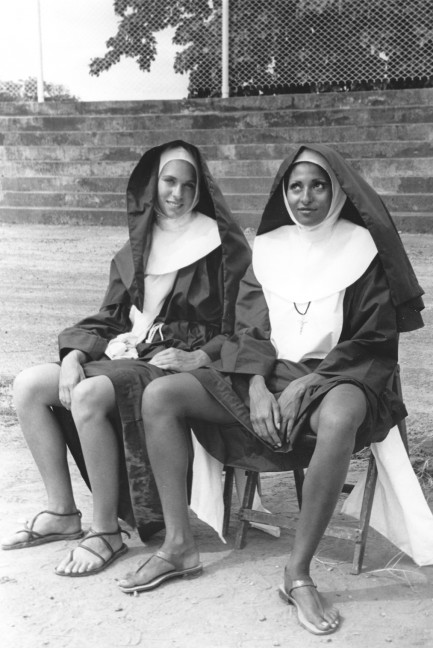
 Anyone hoping for a relaxing weekend should probably choose a different place. 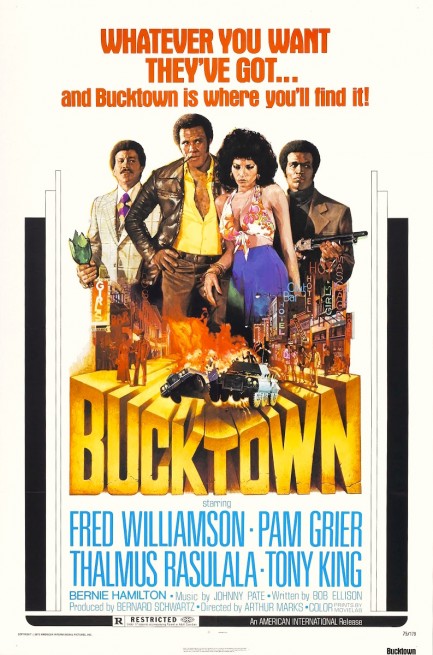
We've featured several blaxploitation posters by George Akimoto, so you could be forgiven for thinking the above effort was also painted by him, especially because it's in a similar photo-realistic style, but it's actually the art of Robert C. Kinyon, a new name to our website. He painted it for the Fred Williamson actioner Bucktown, which premiered in the U.S. today in 1975. We've uploaded close-ups below so you can see some of the nice elements Kinyon included, especially the urban street scene with its overlapping, multi-colored neon lights. We'll be keeping a watch for more art from him.
Obviously we watched this movie, and plotwise Williamson arrives in the eponymous Bucktown to bury his brother, who died of pneumonia. Included in his estate is the local nightspot Club Alabam. Williamson wants to sell it and get out of town, until he discovers his brother died of pneumonia alright—after being beaten and left in the freezing rain for refusing to pay off the local cops. Turns out Bucktown is crooked from the top of the police department all the way down to the bottom of the county clerk's office. Only the mayor is clean, but he's helpless.
The Bucktown cartel tries to shake down Williamson for money owed by his brother, as well as for future nightclub profits, but he isn't the type to be intimidated, so he calls in some out-of-town help. A trainload of northern hustlers arrive and soon it's open warfare as Williamson's backup crew starts shooting down crooked lawmen. It's pretty clear, though, that he's going to have trouble with his helpers. That trouble is worse than he imagined. Once the local law is eliminated his pals take over the town and Williamson is basically back at square one. Lesson: power corrupts.
Pam Grier is in this, which is only half the reason we watched it. The other is Williamson, who we've come to regard as a great screen presence. Grier co-stars as a justice-minded local girl who quickly falls into bed with him. Her early roles usually allowed her to play it tough, but here she's a worried girlfriend—a part that doesn't fit her well or use her talents properly. Even so, she's still the lovely Miss Grier and she gets plenty of screen time. Also aboard is the reliable Thalmus Rasulala as head of the out-of-town invaders, and Carl Weathers as of one of his gunmen.
In the end you wind up with a movie the resides somewhere in the middle ranks of blaxploitation in terms of quality and entertainment value. It's low budget, and only passably acted, but it offers up a vision of smalltown corruption right out of Dashiell Hammett's Red Harvest. In both cases the hero might have been better off heading down the road, but in both cases they're required to stick around and beget some brutal violence. Bucktown barely survives the onslaught, but it's just another day in the realm of blaxploitation.
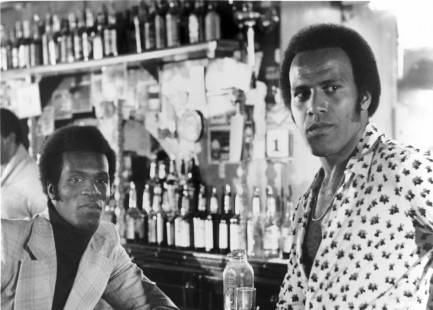 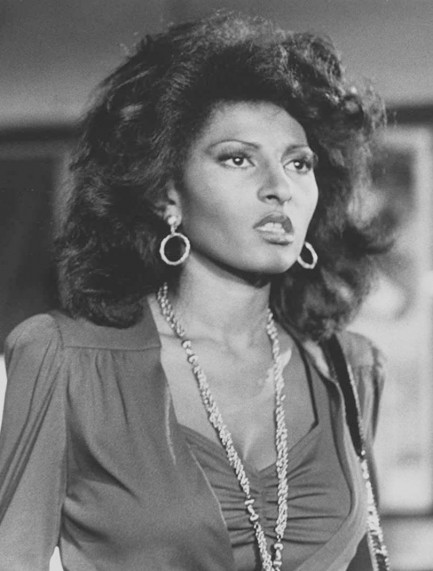 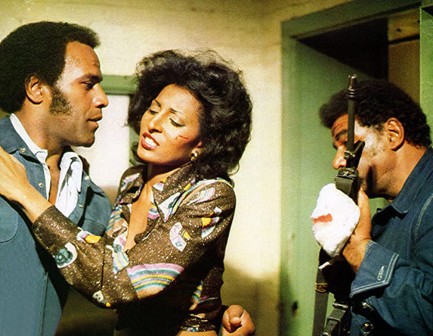 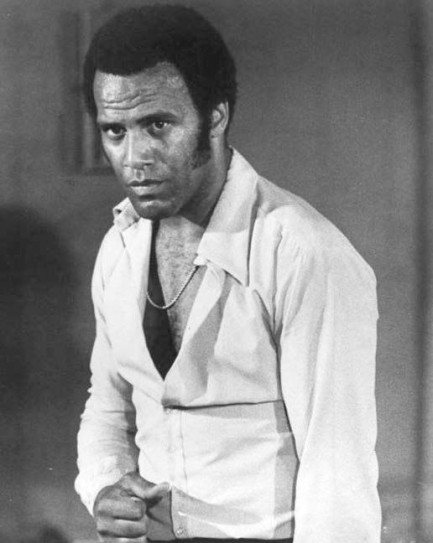 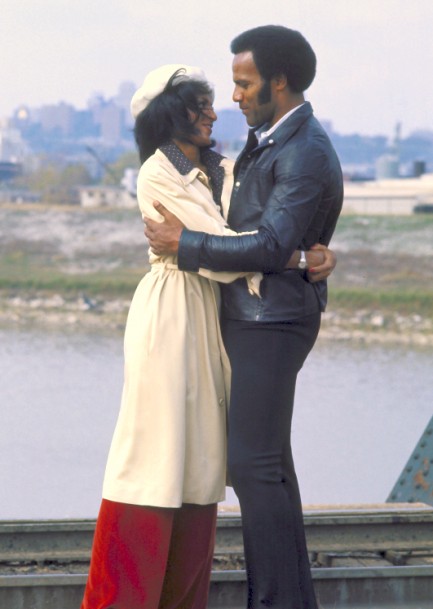 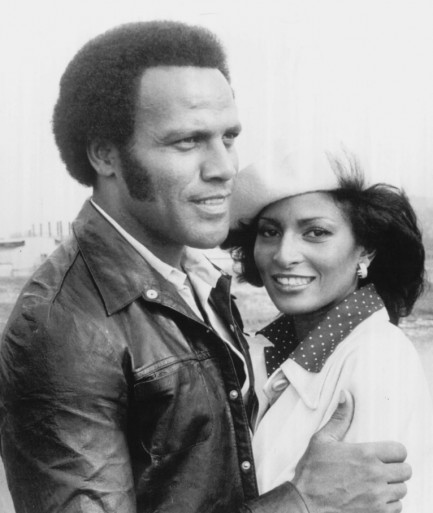 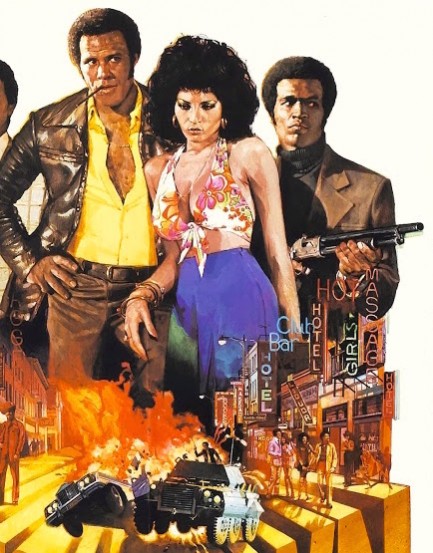 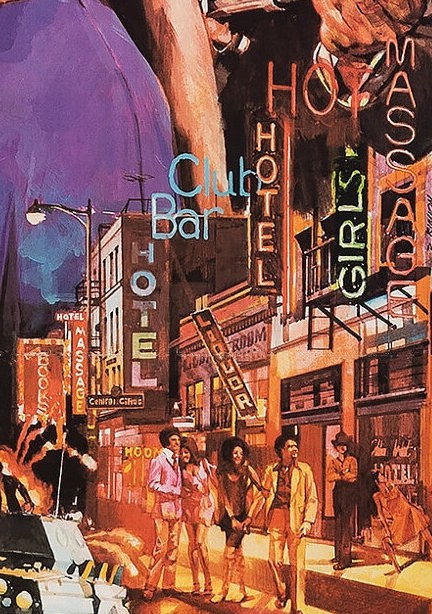 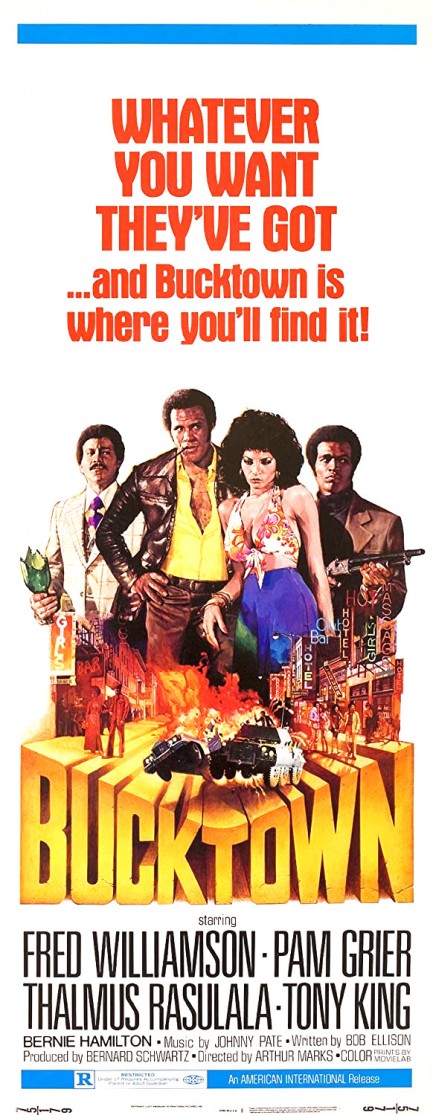
 Gladiatorial combat is all fun and games until the gladiators decide you're the one who needs killing. 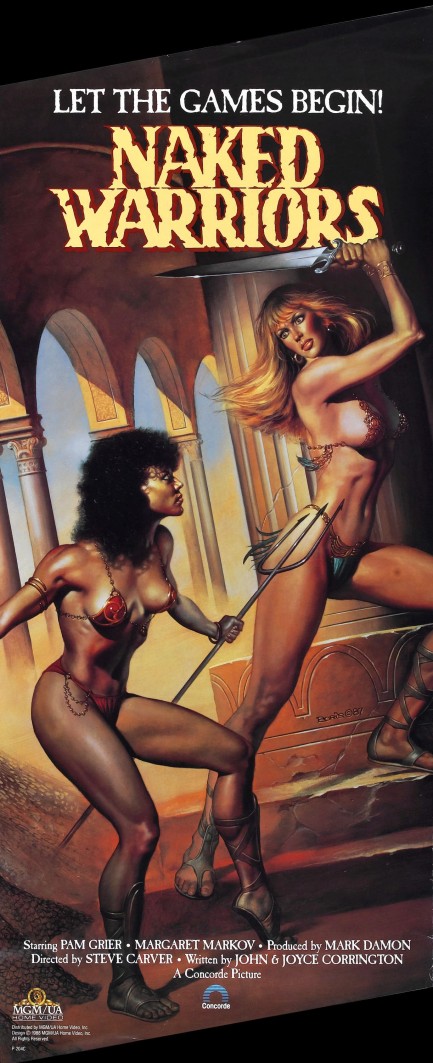
We've featured master fantasy artist Frank Frazetta a few times, so it seems only fair that we feature the yang to his yin, Peruvian born legend Boris Vallejo. Here you see his art on a promo poster for Naked Warriors, which is better known as The Arena, released this month in 1974 starring another legend, Pam Grier, along with occasional co-star, the lovely Margaret Markov. We've talked about the movie twice, shared its Italian and U.S. promo art, and shared rare promo images of Grier once or twice, or maybe even three or four times, as well as a beautiful centerfold of Markov. All of that imagery is worth a look.
Vallejo's art is a nice fit for a tale of enslaved gladiators pitted against each other eventually defying their sadistic masters to fight for freedom. He painted when Corcorde Pictures acquired the rights to the film from MGM/UA for a VHS release in 1988. Concorde/New World was formed and run by schlockmeister Roger Corman, and that explains the black wedges at the top and bottom of the promo. When you do things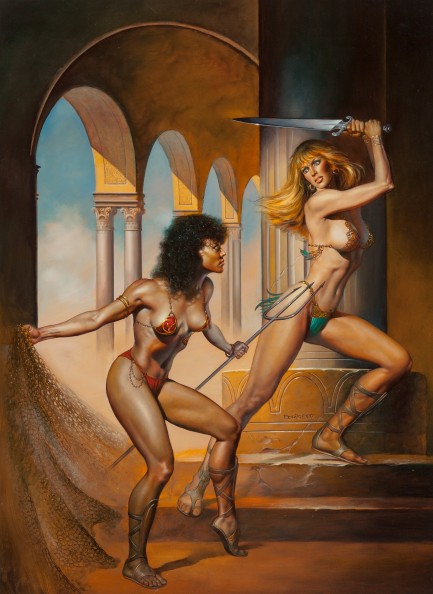 on the cheap as a matter of course like Corman did, tilting the art in an inelegant way to make the two figures fit a door panel format seems logical. We can imagine him: “Just lean the fucker left. Who cares about the blank spots?” And indeed, who does, really? on the cheap as a matter of course like Corman did, tilting the art in an inelegant way to make the two figures fit a door panel format seems logical. We can imagine him: “Just lean the fucker left. Who cares about the blank spots?” And indeed, who does, really?
In addition to a great piece of art, as a bonus we've also uploaded some Arena production photos we found scattered around the internet over the years. Most of them were shot by Italian lensman Angelo Frontoni, whose work we've admired often. As it is a lusty sort of movie, some of the shots are a bit lusty too. We had these sitting about and didn't have a real good excuse to share them until today, so from the good old days of ’70s sexploitation behold: Grier, Markov, Lucretia Love, Maria Pia Conte, Rosalba Neri, and others in barely-there gladiatorial gear—and sometimes less. We can't say the film is perfect, but it's definitely worth a watch. 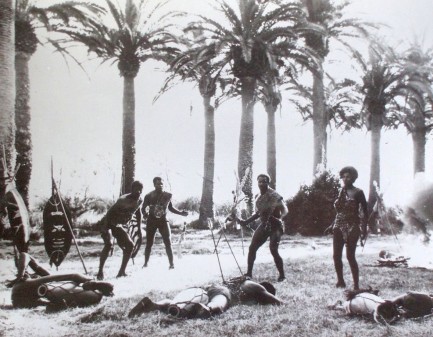 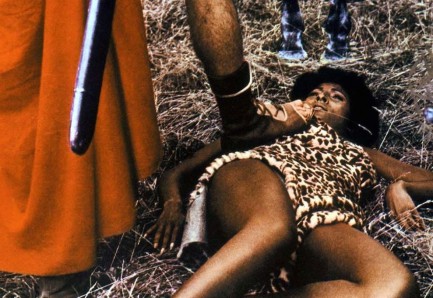 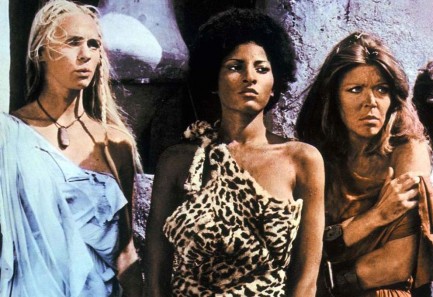 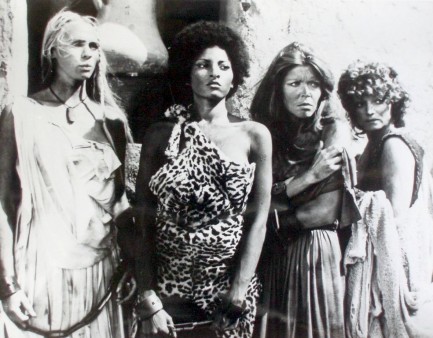 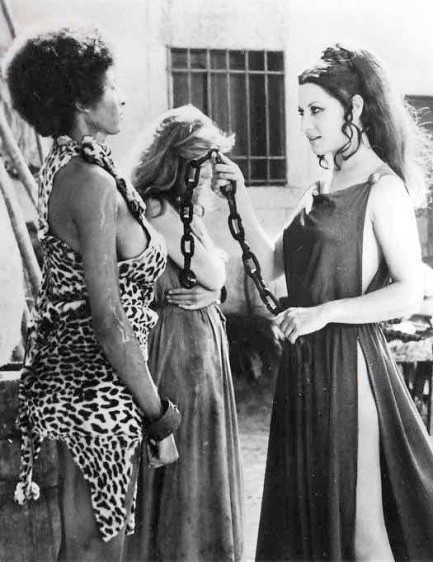 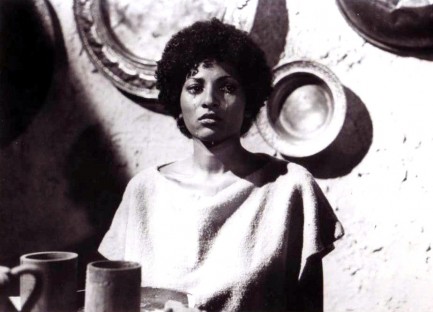 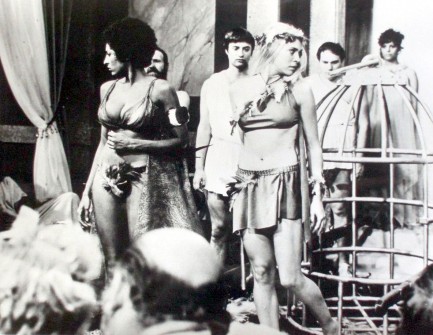 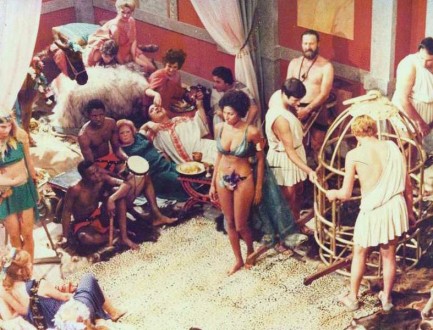 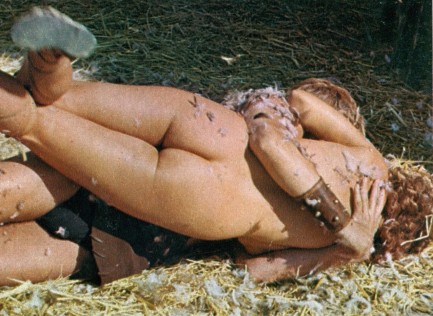 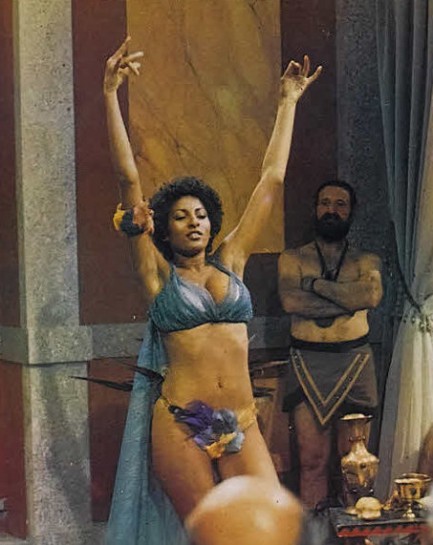 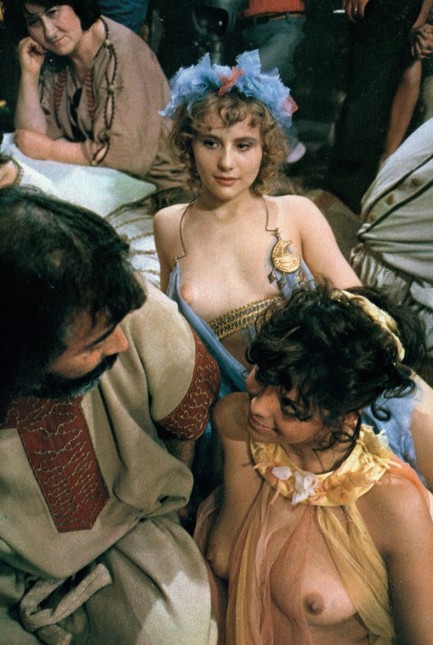 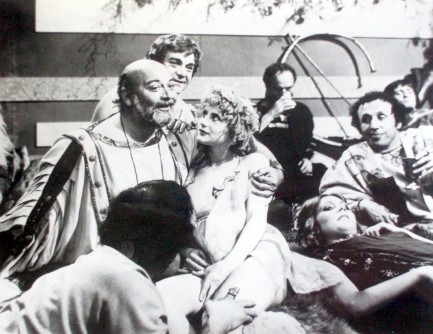 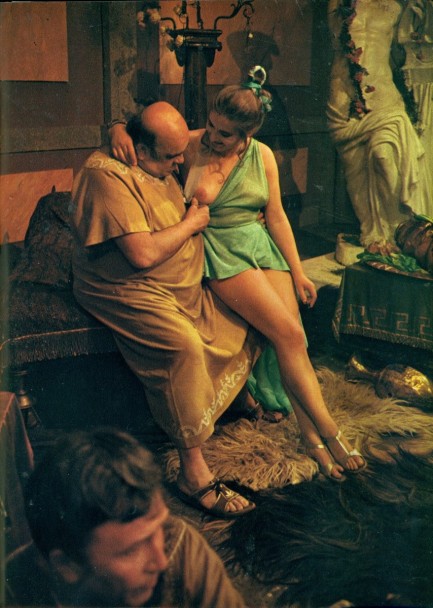 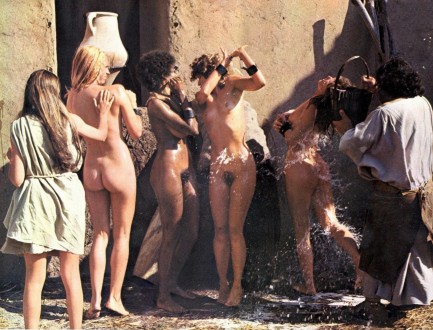 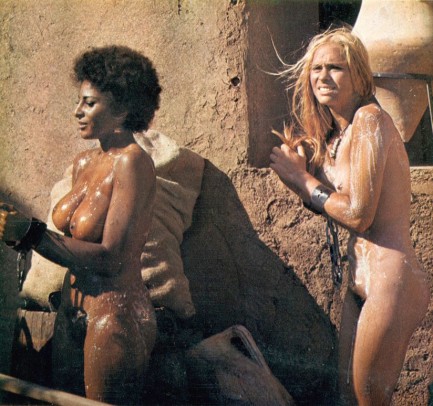 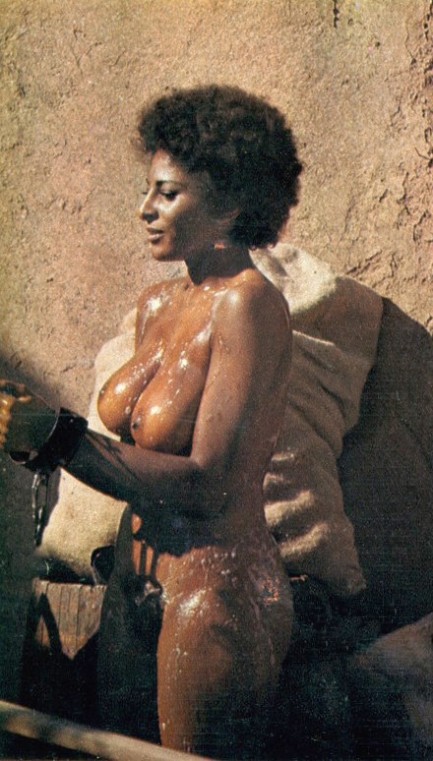 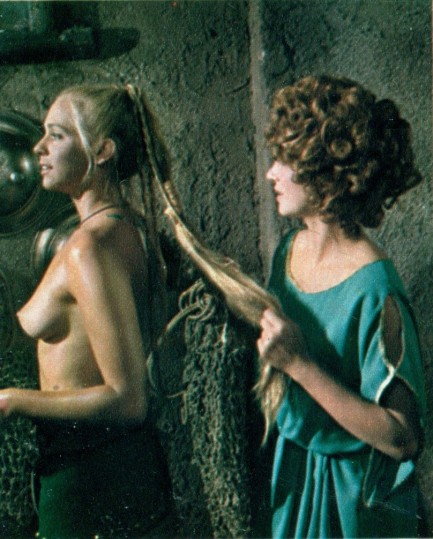 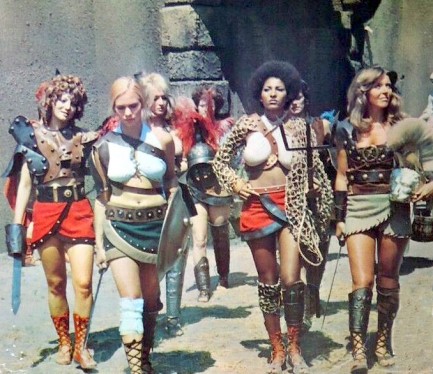 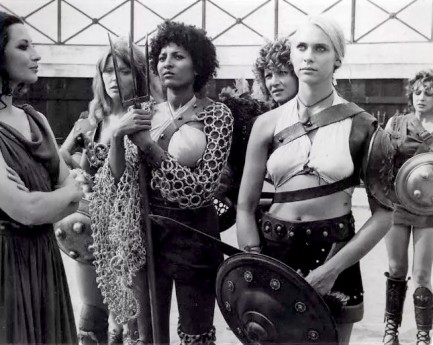 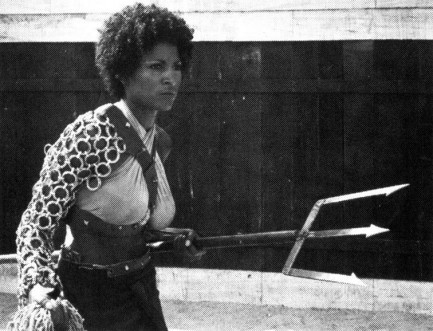 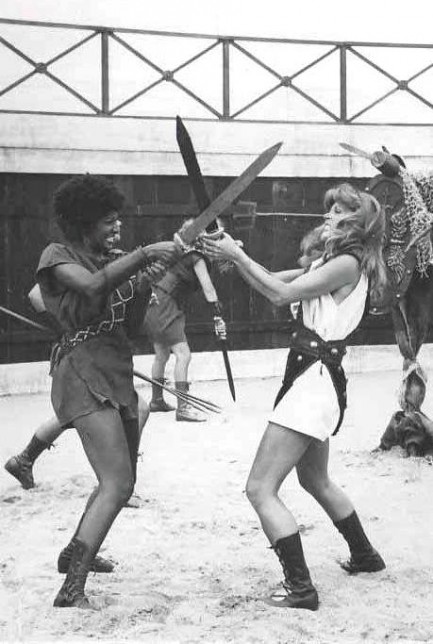 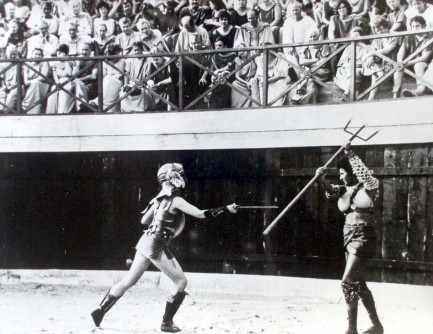 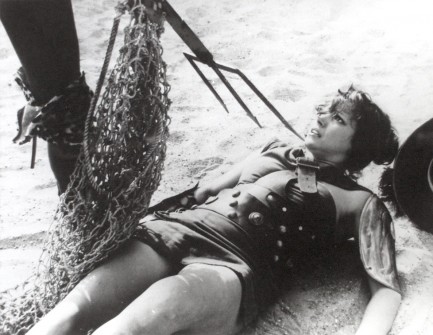 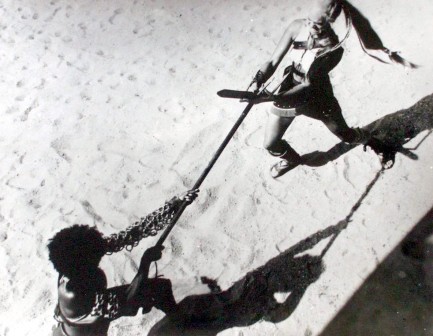 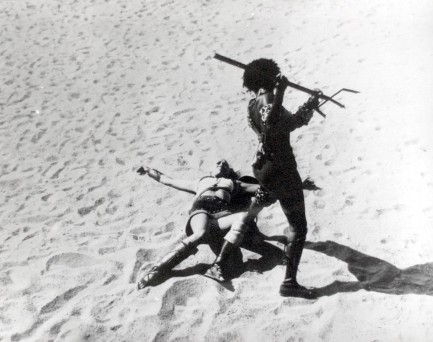 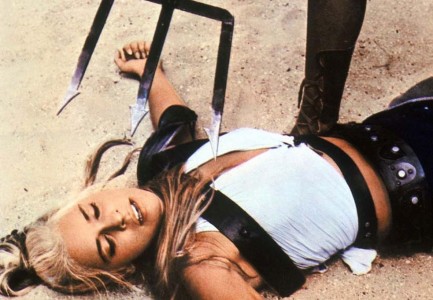 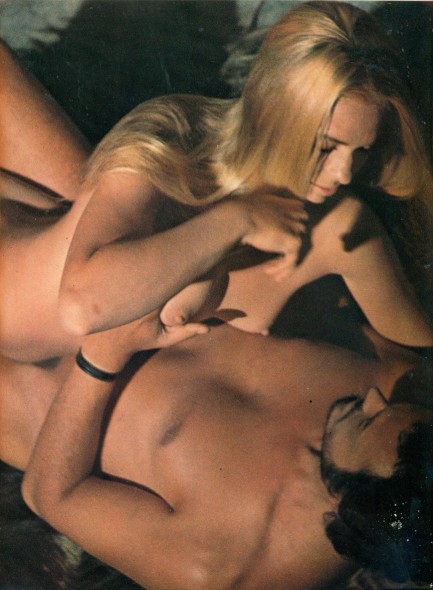
 Coffy gets scalding hot in explicit novelization. 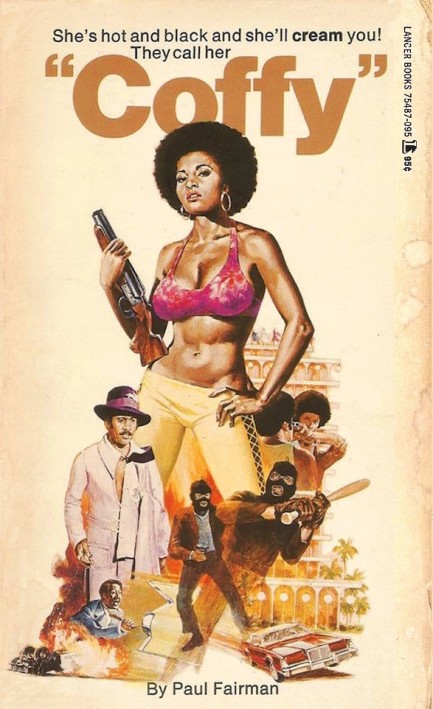
A novelization of the blaxploitation classic Coffy? We had to buy it. Paul Fairman was tapped to bring the iconic character of Coffy to literary life, and we were surprised to discover that the result is x-rated. We assume Fairman's marching orders came from Lancer Books or/and American International Pictures, and in a way it's a clever gambit—readers had no choice but to imagine Pam Grier dispensing the blowjobs and sizzling bed sessions described. Unfortunately, the other edge of that sword is Fairman has Coffy raped, which didn't happen in the movie (though she was seriously threatened with such). Except for the kicked up explicitness, the tale hews close to the motion picture, with Coffy seeking bloody revenge against the degenerates who addicted her eleven-year-old sister to heroin.
Fairman writes with as much soul as he can muster, but it's quickly discernible that he doesn't exactly have his finger on the pulse of the black community. Some of his attempts at African American vernacular are cringeworthy, especially the constant interjections of, “Sheeee-it!” We really don't think many black authors would have made that choice, and Fairman, who's not black and is no Toni Morrison, should have rethought it. The book has this and numerous other flaws, and isn't well written overall. At least Fairman solved the mystery of Coffy's real name, sort of. Her last name is Coffin. In the movie her sister calls her Flower Child, but we feel like that's understood to be a nickname. Here she's asked directly if that's her real name. She responds with a quip about nobody being around when her birth certificate was made. So we guess it's officially Flower Child.
We managed to get Fairman's Coffy for seven dollars plus shipping. We've seen sellers ask for a lot more, even as much as eighty dollars, but we'd caution against extravagant expenditure. You get less than you expect. The book has extra large type to help pad it into a normal sized paperback. With regular type, leading, and kerning we think it would run maybe 100 pages. Instead of typographic tricks, a more detailed portrayal of Flower Child Coffin would have been better, but no such luck. Even so, we're glad we bought Fairman's novelizationsploitation. If we hadn't, we would have wondered about its contents forever. The cover art on this is uncredited, but it comes directly from the film poster. That art, in turn, is rarely attributed, but it's by George Akimoto. Excellent work.
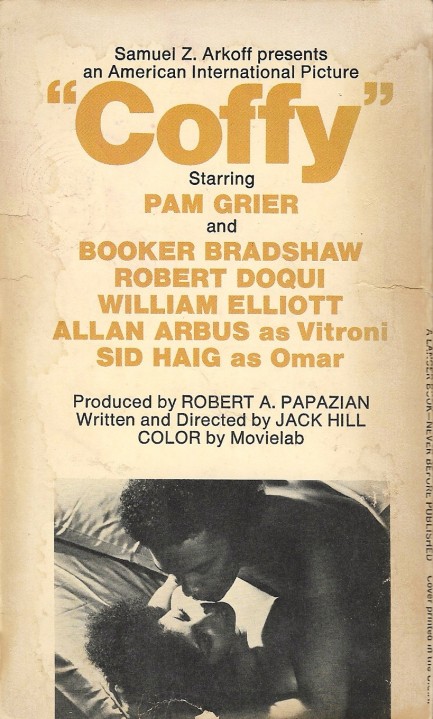
 You know that fist bump thing? I invented it way back in the ’70s except it was my fist and their faces. 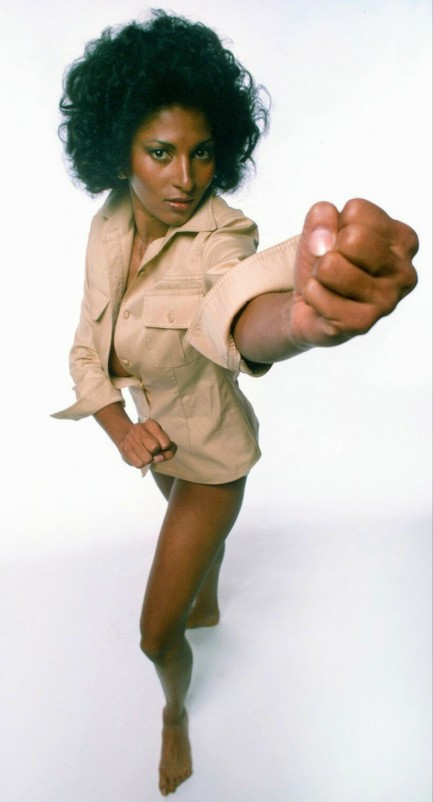 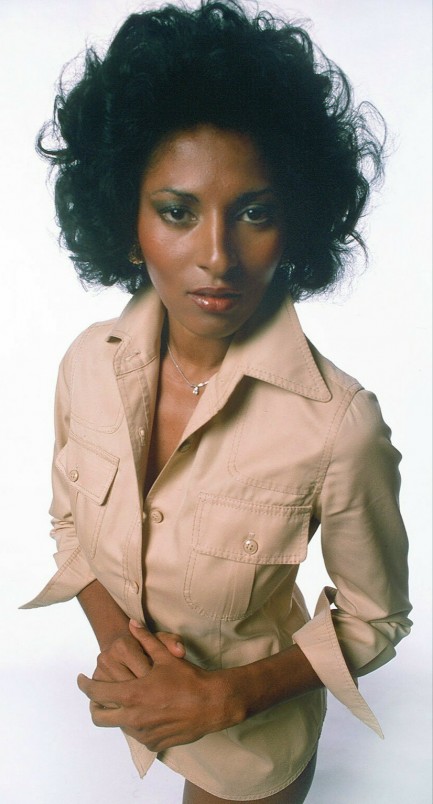
We've commented before about how, generally speaking, actresses from the blaxploitation era don't have much in the way of surviving promotional material. It's possible few promos were ever made. Pam Grier is an exception. She was one of the top performers to come out of blaxploitation, was also an impact presence in the women-in-prison niche, and really, was probably the first woman you could call an action star. We say probably to hedge our bets, but we can't think of a counter example, unless, maybe, we look at Japanese film. In any case, because Grier was an important figure she was reasonably well photographed. Previously unseen shots appear regularly. The two images above, which turned up online earlier this year, are excellent additions to her cinematic legacy. They were shot in 1975, and are part of the series that produced the well known image below that appeared inside an issue of New York magazine. 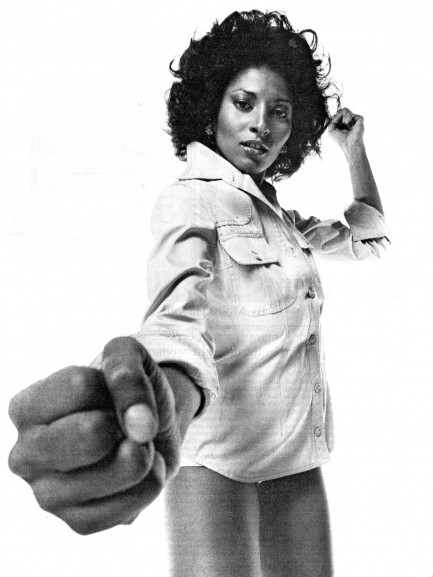

|
 |

The headlines that mattered yesteryear.
2003—Hope Dies
Film legend Bob Hope dies of pneumonia two months after celebrating his 100th birthday. 1945—Churchill Given the Sack
In spite of admiring Winston Churchill as a great wartime leader, Britons elect
Clement Attlee the nation's new prime minister in a sweeping victory for the Labour Party over the Conservatives. 1952—Evita Peron Dies
Eva Duarte de Peron, aka Evita, wife of the president of the Argentine Republic, dies from cancer at age 33. Evita had brought the working classes into a position of political power never witnessed before, but was hated by the nation's powerful military class. She is lain to rest in Milan, Italy in a secret grave under a nun's name, but is eventually returned to Argentina for reburial beside her husband in 1974. 1943—Mussolini Calls It Quits
Italian dictator Benito Mussolini steps down as head of the armed forces and the government. It soon becomes clear that Il Duce did not relinquish power voluntarily, but was forced to resign after former Fascist colleagues turned against him. He is later installed by Germany as leader of the Italian Social Republic in the north of the country, but is killed by partisans in 1945.
|

|
|

It's easy. We have an uploader that makes it a snap. Use it to submit your art, text, header, and subhead. Your post can be funny, serious, or anything in between, as long as it's vintage pulp. You'll get a byline and experience the fleeting pride of free authorship. We'll edit your post for typos, but the rest is up to you. Click here to give us your best shot.

|
|



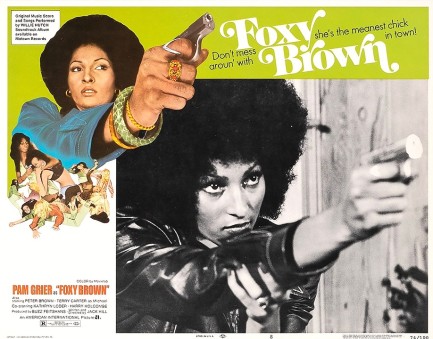
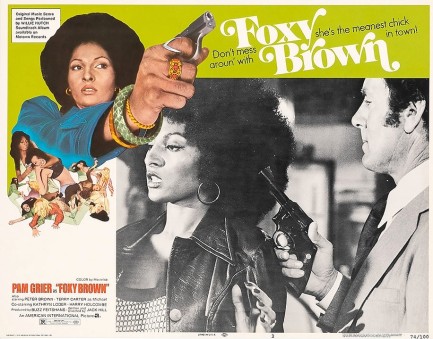
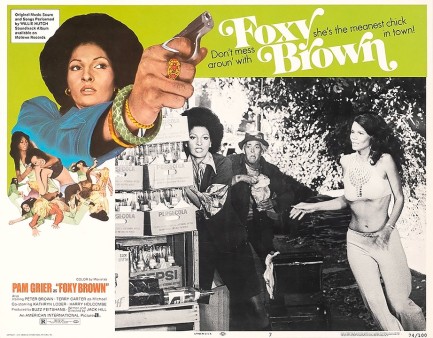
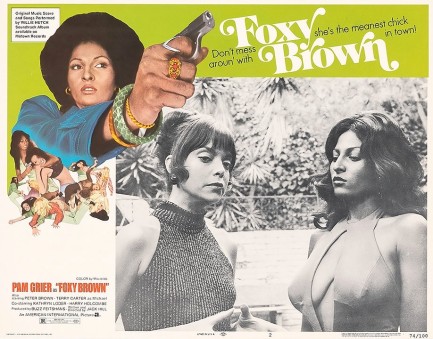
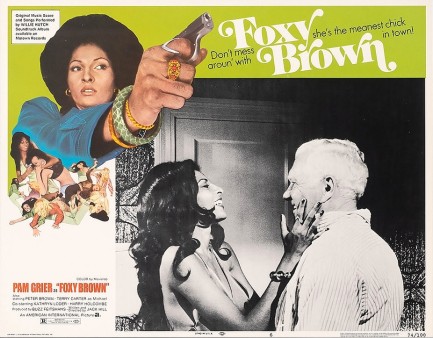
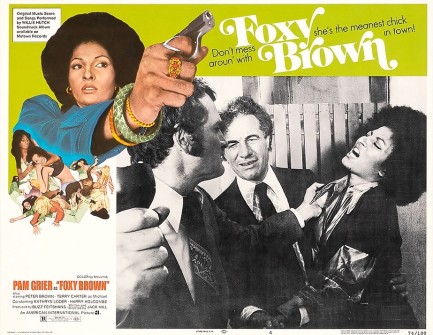
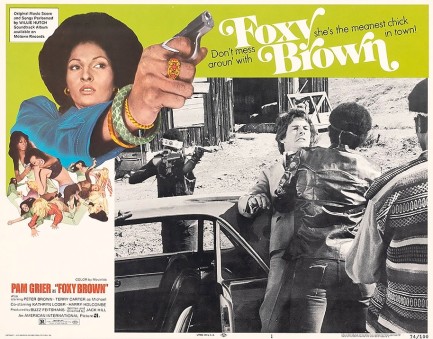
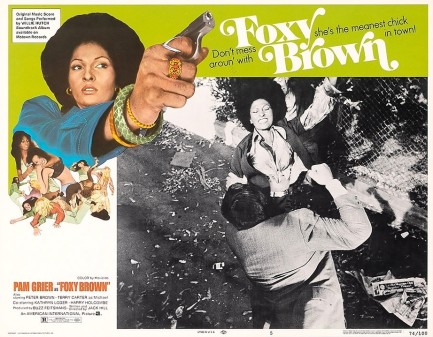





 Above you see a rare image from Players magazine circa 1974 of cinema legend Pam Grier using a device known as a rotary telephone. It's a great shot of both her and the museum piece. A couple of other frames from her hang-out session exist that were used in the offshoot publication Players Girls Pictorial in 1976.
Above you see a rare image from Players magazine circa 1974 of cinema legend Pam Grier using a device known as a rotary telephone. It's a great shot of both her and the museum piece. A couple of other frames from her hang-out session exist that were used in the offshoot publication Players Girls Pictorial in 1976.
















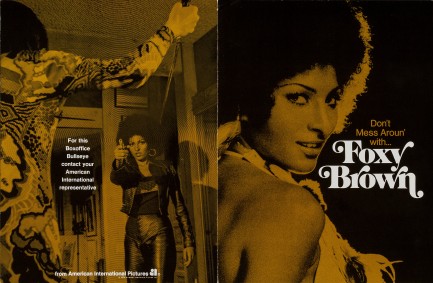
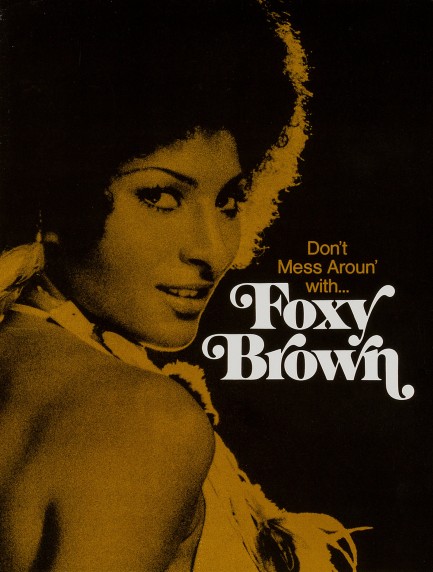
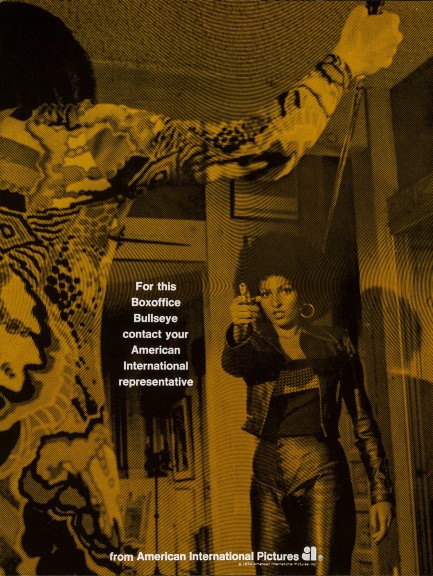
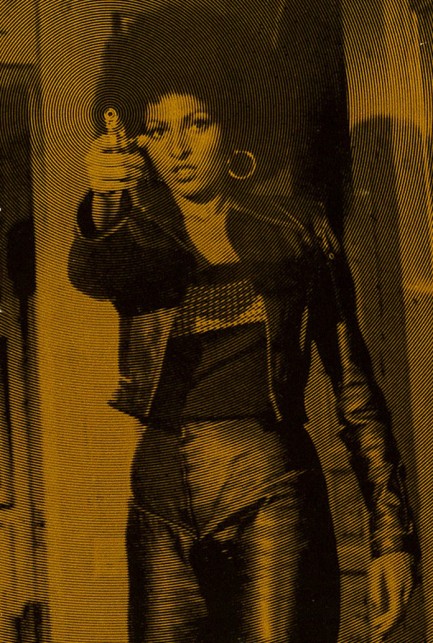


 on the cheap as a matter of course like Corman did, tilting the art in an inelegant way to make the two figures fit a door panel format seems logical. We can imagine him: “Just lean the fucker left. Who cares about the blank spots?” And indeed, who does, really?
on the cheap as a matter of course like Corman did, tilting the art in an inelegant way to make the two figures fit a door panel format seems logical. We can imagine him: “Just lean the fucker left. Who cares about the blank spots?” And indeed, who does, really?






































































































